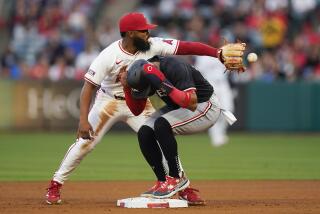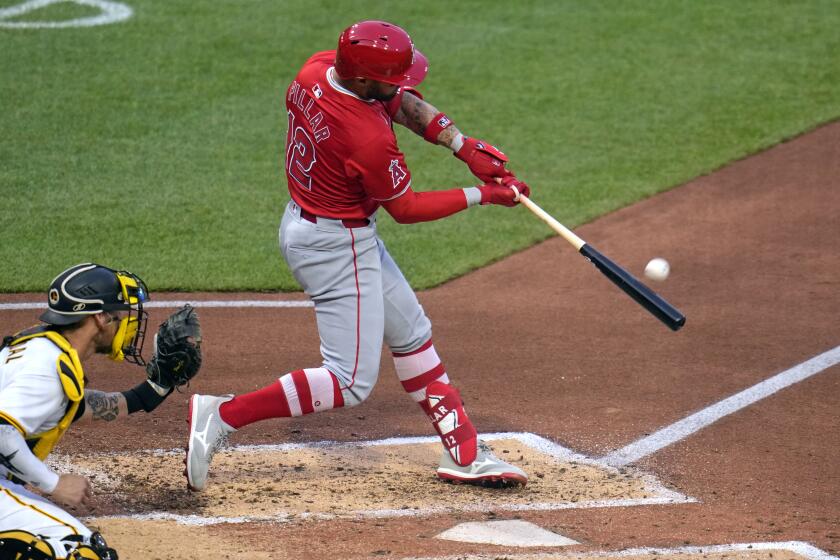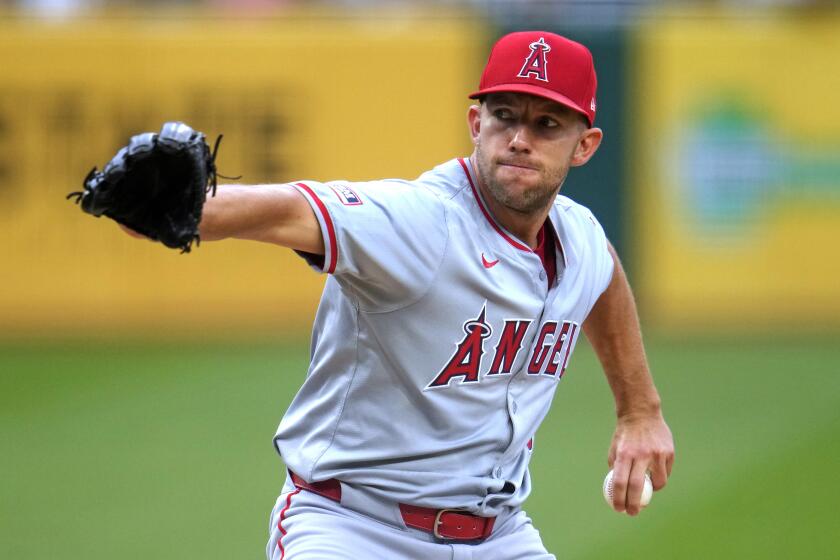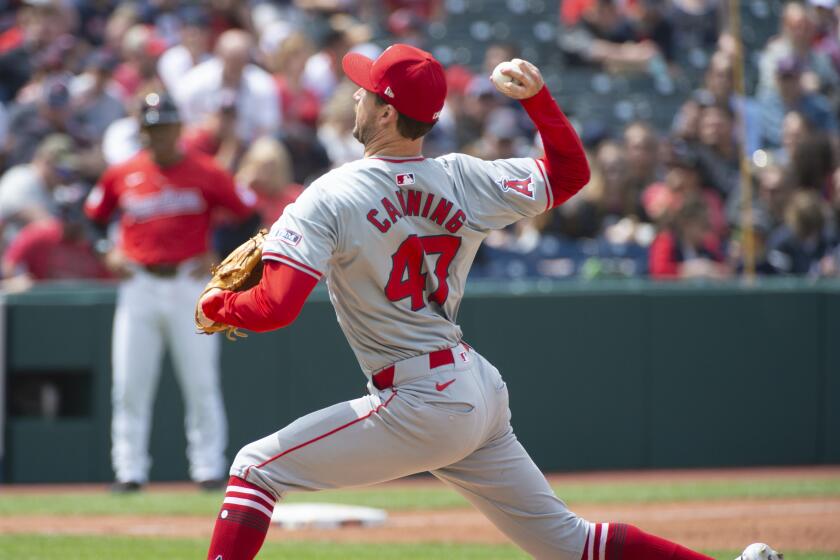‘BYE NOW, PAY LATER
Standing at his locker shortly before the Angels’ home opener against the Toronto Blue Jays, outfielder Vernon Wells had mixed emotions about facing the team that traded him away last winter. ¶ It would be good to see old friends, but he also wanted to defeat them. And there was an added twist. ¶ Wells was playing against a Toronto ballclub that was still covering part of his salary. ¶ “It’s obviously strange,” he said. ¶ Not in baseball, it isn’t. ¶ Call it “sunk costs” or “dead money” -- teams’ still paying for athletes no longer on their rosters. ¶ Juan Pierre, Andruw Jones and Manny Ramirez remain on this season’s payroll for the Dodgers, though Ramirez is retired, Pierre is with the Chicago White Sox and Jones is with the New York Yankees. ¶ The Angels took Wells only after Toronto agreed to contribute $5 million toward the remainder of his hefty contract. At the same time, the Angels have Gary Matthews Jr., who is out of the game, on their books for more than $11 million this season.
Sunk costs often trace back to a general manager paying tens of millions for a free agent, sometimes stretching those costs over many years, other times unloading him at a loss.
“A team believes the player is worth $10 million a year, then it turns out he’s worth only $5 million,” said J.C. Bradbury, a sports economist and author of “Hot Stove Economics: Understanding Baseball’s Second Season.” “A bad decision has been made.”
But that’s not always the case. Bradbury and others around the game suggest that some dead money is unavoidable. As Ned Colletti, general manager of the Dodgers, said: “It’s inherent in the way we do business.”
In a perfect world, teams would fill their rosters with young players developed through the farm system. Those players must wait two to three years before qualifying for salary arbitration and must log six seasons of major league service to become eligible for free agency.
In the real world, teams bolster their lineups with free agents, knowing the science of predicting future performance is imperfect. This year, a dozen teams around the majors are carrying sunk costs.
The New York Mets are paying four former players more than $20 million, according to media reports.
The Houston Astros are covering roughly half of the $22 million they owed pitcher Roy Oswalt when they traded him to the Philadelphia Phillies over the summer. The White Sox sent pitcher Scott Linebrink to the Atlanta Braves along with $1.5 million to offset the $5.5 million he will receive.
The numbers grow even more complicated for shortstop Yuniesky Betancourt, who has changed teams three times. According to the online site Cot’s Baseball Contracts, the Seattle Mariners will pay about $1 million of his 2011 contract to the Kansas City Royals, who will forward about $2 million to his current team, the Milwaukee Brewers.
Supply and demand have much to do with sunk costs. As teams compete for a limited number of free agents, the cost and duration of contracts get driven upward.
“They’re pursuing players who have been very successful,” agent Scott Boras said. “The acquisition costs may be above the market [value].”
Wells got a seven-year, $126-million contract extension to stay in Toronto before the 2007 season and was later considered a disappointment. “Just because you make more money, that doesn’t mean you automatically become a better ballplayer,” he said.
Entering the 2007 season, the Dodgers had a dearth of outfielders and were looking at a market where free agents such as Alfonso Soriano and Carlos Lee figured to command $100 million or more.
“Sometimes you get in a situation where you really need a particular player to fill a gap and sometimes it’s going to take an extra year or a couple million more on the contract to get him,” Colletti said. “You end up doing something that isn’t necessarily easy to do.”
The team went after a less flashy Pierre, signing him for $44 million over five years. That same winter, the Angels gave a five-year, $50-million contract to Matthews, who had more power but a less proven track record.
Fast-forward a few years. The Angels -- who declined to comment for this story -- dumped Matthews at a loss after three seasons of poor hitting and reports linking him to performance-enhancing drugs.
The Dodgers, meanwhile, had gradually built an outfield of Manny Ramirez, Matt Kemp and Andre Ethier. They traded Pierre to the White Sox, eating much of his salary but freeing the remainder to use elsewhere.
“Teams will say, I really wish we had that money,” said Bradbury, an associate professor at Kennesaw State University in Georgia. “They could use it for another player. Maybe it’s coaching or a scouting academy.”
Dead money on the payroll can stack up in other ways, including deferred payments. Players who sign immense contracts sometimes allow cash-strapped teams to stretch out the payments.
Ramirez will be collecting for several more years on a $45-million contract the Dodgers gave him in 2009 -- despite the fact that he recently retired amid reports of a third positive test for PEDs.
The Dodgers unloaded Jones after a 2008 season in which he hit .158 with three home runs and 14 runs batted in. They owed him $22.1 million, which they are paying in annual installments through the 2014 season.
Jones had no regrets about it, telling The Times in 2009: “I got paid that money because that was my value.”
The payments to Ramirez and Jones pale in comparison to the deal Bobby Bonilla worked out. When the Mets released him in 2000, they were still on the hook for $5.9 million remaining on his deal. Needing cash to sign free agents, they asked to defer those payments for more than a decade, with interest.
As a result, the Mets now pay Bonilla -- who is retired and working for the players’ union -- more than $1 million annually for 25 years. That number might seem outlandish, but Bradbury tells fans to take a closer look at the economics of the game.
“You don’t want to see general managers make decisions based on dead money,” he said. “You don’t want them playing a guy just because they’re paying him a lot of money.”
After releasing Bonilla, the Mets acquired first baseman Todd Zeile, outfielder Derek Bell and pitcher Mike Hampton, talent that helped them reach the World Series that season.
Colletti says teams cannot be afraid to admit their errors and move on. “My first boss, Dallas Green, used to say that all the time,” he recalled. “The worst mistake sometimes isn’t the first one, it’s the second one.”
And if fans criticize the front office for absorbing sunk costs, at least general managers can try to balance the ledgers with homegrown talent that works for less than market value.
Bradbury points to the San Francisco Giants’ young catcher, Buster Posey, who will make $575,000 this season, still waiting for a bigger payday when he qualifies for arbitration and free agency down the road.
“Fans are upset that you paid Edgar Renteria too much,” Bradbury said of the Giants’ shortstop last season, “but you don’t get credit for the shrewd move.”
Ultimately, dead money might represent the market correcting itself. When an overpriced player gets traded, his new team ends up paying a more realistic price.
“The new market is looking at the player, thinking they want this to be a great deal,” Boras said. “They are getting what was a higher value player for a lower cost.”
Wells, who had a run-scoring single against his old team but has struggled at the plate through the first month of the season, is hoping that means a fresh start.
“The money side of it can’t play a factor in anything you do on the field,” he said. “All that matters are the guys in the clubhouse and how they feel about you as a player and what you can do to make the team better.”
twitter.com/latimeswharton
More to Read
Go beyond the scoreboard
Get the latest on L.A.'s teams in the daily Sports Report newsletter.
You may occasionally receive promotional content from the Los Angeles Times.





